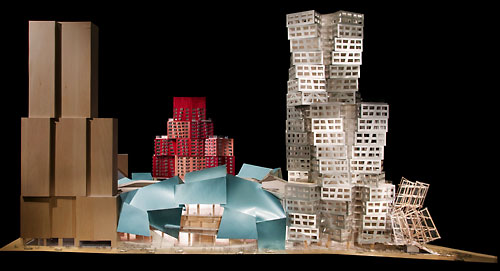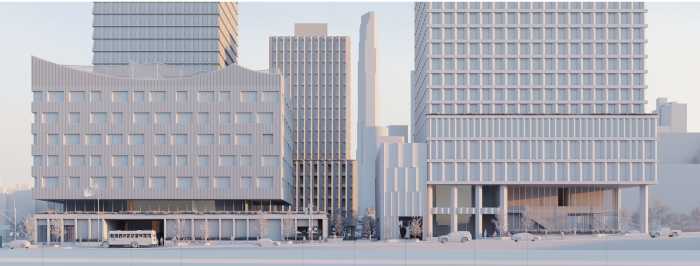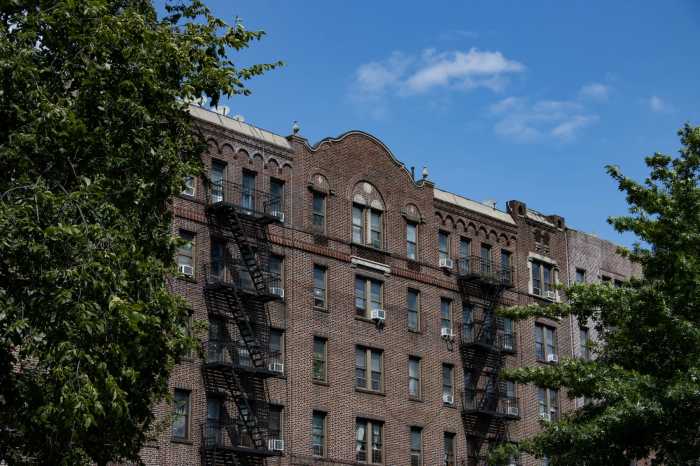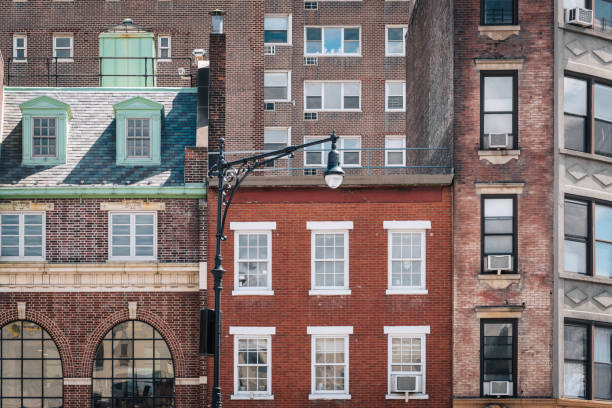Chronic financial problems at Atlantic Yards have caused another casualty on the embattled project — Frank Gehry’s ambitious design for both the arena and the rest of the 16-building project has been scrapped for a cheaper and widely criticized blueprint.
Last Thursday’s announcement by developer Bruce Ratner that one of the project’s main selling points had been eliminated was not a surprise, given that reports have been circulating since December that Gehry’s role in designing the Barclays Center arena had been scaled back in a drastic effort to curb construction costs that galloped to $1 billion, up from an original $555 million.
But still, the loss of the internationally renowned genius behind such iconic buildings as the Disney concert hall in Los Angeles and the Guggenheim Museum in Bilbao, Spain, was a huge blow to project supporters — such as Mayor Bloomberg, Borough President Markowitz and Ratner himself, who have always mentioned Gehry’s involvement with the project as crucial to its success.
“Frank Gehry is one of the world’s most respected and celebrated architects,” Ratner’s official Atlantic Yards Web site still said this week, despite Gehry’s terminated affiliation with the project. “Because Atlantic Yards will be an important part of the transformation taking place in Downtown Brooklyn, Forest City Ratner sought out an architectural team that could make significant contributions to Brooklyn while remaining sensitive to the context of the surrounding neighborhoods. [Gehry’s] long, soaring forms have become recognized as a style all his own.”
In a statement last week, Ratner continued to praise Gehry, even as he announced that the starchitect and his critically acclaimed design had become casualties to lawsuits brought by Atlantic Yards opponents and the bearish economy.
“I have an immense gratitude toward Frank Gehry for his amazing vision, unparalleled talent and steadfast partnership,” Ratner said.
“Throughout this process — as litigation produced delay; as rising construction costs impacted the budgets of all developers; and a slowing economy altered expectations — Frank and his team have shown remarkable flexibility and professionalism, making cost-effective revisions as needed. The current economic climate is not right for this design, and with Frank’s understanding, the arena is undergoing a redesign that will make it more limited in scope.”
Gehry parted with solemn words, saying, “We remain extremely proud of our work on the Atlantic Yards master plan and on the original arena, which we designed in close collaboration with Forest City Ratner. While there are always regrets at designs not realized, we greatly appreciate our ongoing relationship with Bruce and his team.”
Forest City announced that the project would be completed by Ellerbe Becket, a firm that has designed 15 NBA and NHL arenas. A rendering put out by the company indicates a fairly common design.
Gehry’s departure is the latest reduction in the project’s grand original goals. Ratner had already abandoned Gehry’s whimsical “Miss Brooklyn” tower, the signature skyscraper that would have stood at the corner of Flatbush and Atlantic avenues.
The revised plans from Becket will cost $200 million less than Gehry’s lavish creation. The savings are not just in the aesthetics — the new arena will be less functional. Unlike the original Barclays Center blueprints, the simpler model will not be large enough for National Hockey League specifications, forestalling the possibility of the New York Islanders moving to Brooklyn from their much-loathed arena in Nassau County.
Critics of Atlantic Yards unleashed a swift backlash against the change, accusing Ratner of a classic bait-and-switch and trying to appear to be frugal with public money at the project’s low-water mark of public support.
“Embracing a different design that scales-down the project does not address the inherent problems with the Atlantic Yards proposal or process, nor does it convince me that this wasn’t a quick attempt to gain support through a supposed ‘budget-conscious’ design,” said Councilwoman Letitia James (D-Fort Greene).
Councilman David Yassky (D–Park Slope) said Forest City should give back the reimbursements that it’s already received.
“Taxpayers should not be padding the bottom line of a private company,” he said. “Forest City Ratner should give back the $40 million of taxpayer money they’ve taken with nothing to show for it,” Yassky said.
Few would have imagined that there would be so little built by now. Five years ago, at the star-studded unveiling of Atlantic Yards, pols heaped praise on the project — and virtually all cited Gehry as the reason for its coming greatness.

“Brooklyn is a world-class city and it deserves a world-class architect,” Borough President Markowitz said at the Borough Hall event in 2003.
Mayor Bloomberg praised Gehry’s anticipated contribution, too.
“Frank Gehry … will [create] a truly monumental achievement,” he said.
Now Markowitz, whose longtime support for Gehry’s design softened earlier this year when out-of-control costs threatened the viability of the entire $4-billion mega-development, is singing a different tune. This week, he urged Ratner to press ahead without the Los Angeles-based genius.
“The great architect Frank Gehry has been absolutely central to creating the guiding vision for this project, and Ellerbe Becket is one of the best firms in the business — so we can be confident that the Nets and Brooklyn will indeed have a world-class, stunning arena here in Downtown Brooklyn and we will be bringing more affordable housing to those who so desperately need it,” he said in a statement.
Daniel Goldstein, a spokesman for Develop Don’t Destroy Brooklyn the principal opposition group to the project, called Gehry’s departure “a big problem for Ratner.”
“The project that was approved [in 2006] no longer exists,” he said. “Is Barclays going to pay $400 million to put their name on what will be an airport hanger? Will other sponsors stick with a building that is no longer Gehry, no longer world-class building?”
Goldstein also mentioned that other benefits of the project, including tax revenues, have also been scaled back.
“It’s a bad project that has gotten worse,” he said. “The alleged benefits are diminising on a daily basis. The state needs to step in.”
Gehry’s design — one of the alleged public benefits of the project — was doomed from the onset, one architect claimed.
“Gehry’s designs, as magnificent as they are, are not for the faint of heart,” said Robert Scarano, a controversial architect based in DUMBO. “They’re only for those with unlimited budget. When they’re wildly overpriced to begin with, the real drama comes later when there are 80 percent cost escalations,” which is what happened at Atlantic Yards.
Scarano bestowed a mild endorsement for the new rendering from Ellerbe Becket.
“It’s a more simple building. In its own right it has some architectural qualities,” he said.
The key is its ability to foster street life — which was one of the primary goals of Gehry’s design. The so-called “Urban Room,” the soaring public atrium that fronted the glass-walled arena, is no longer a part of Atlantic Yards.
“It’s not so obvious how the interplay of the glass façade materials will interact with the pedestrian space — that’s where the action’s going to be before and after the games,” Scarano said.


























